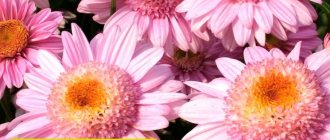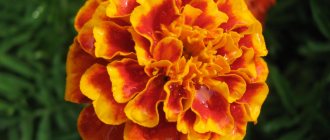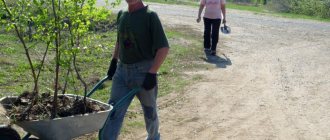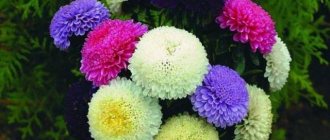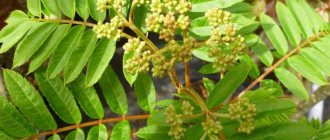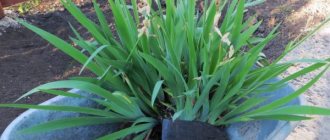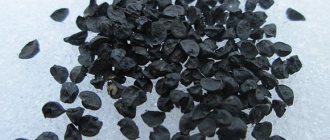Author: Natalya Category: Garden plants Published: January 26, 2019Republished: February 27, 2019Last edits: January 13, 2021
- When to plant
- How to care for aster
- Care after flowering
- What aster
- alpine aster
- Garden aster, or callistephus
Autumn over the shady park... The gold of the maples lies on the waters of the pond. The leaves are spinning... The birds have fallen silent... Aster looks into the cold sky, a radiant aster - a star
Aster is a fairly unpretentious plant, but very sensitive to watering: both excessive soil moisture and prolonged drought can cause harm. Another weak point of asters is their susceptibility to fungal diseases. For example, Fusarium wilt, once penetrating into an astrarium, can destroy it literally in a day! To prevent bacterial and viral diseases, the area under asters must first be “hardened”: pour boiling water on it or make a fire.
- What sowing tricks will protect your asters from the insidious fusarium?
- Why shouldn’t you store the seeds of the asters you like for a long time?
- How does aster interact with marigolds and calendula?
- How to grow perennial aster?
Let's figure it out together.
Planting and caring for asters
- Planting: sowing seeds in early spring (in March) or before winter in open ground or in the second half of March for seedlings. Planting of seedlings - in April or May.
- Flowering: summer, autumn.
- Lighting: bright sunlight, partial shade.
- Soil: fertile, cultivated loam to a depth of 20 cm.
- Watering: moderate. In hot weather - less often, but more abundantly.
- Feeding: 3 per season: a week after emergence, during budding and at the beginning of flowering.
- Reproduction: annuals - by seeds, perennial species usually vegetatively (by dividing the bush and cuttings).
- Pests: slobbering pennies, spider mites, leaf and root-knot nematodes.
- Diseases: powdery mildew, ring spot, gray mold of flowers, verticillium wilt and viral jaundice.
Read more about growing asters below.
Aster (lat. Aster) is a genus of annual and perennial herbaceous plants of the Asteraceae, or Asteraceae, family, numbering, according to various opinions, from 200 to 500 species, most of which grow in North and Central America.
The aster flower was secretly brought to Europe in the 17th century from China by a French monk. Translated from Latin, “aster” means “star”. There is a Chinese legend about how two monks, trying to reach the stars, climbed the highest mountain of Altai for many days, but when they reached the top, the stars above them were still far away and just as inaccessible. Then they, disappointed, without food and water, having spent many hard days on the road, returned to the foot of the mountain and saw a wonderful meadow with beautiful flowers. “Look,” said one monk, “we were looking for stars in the sky, but they live on earth!” The monks dug up several flowers, brought them to their monastery, began to grow them and gave them the star name “asters”. Since then, asters have become a symbol of beauty, elegance, modesty and charm in China. Aster is a flower for those born under the sign of Virgo, a symbol of dreams of the unknown, a gift from God to man, his amulet, his guiding star...
Possible problems in growing
What problems might a gardener encounter when growing asters?
Problems with leaves
The leaves may turn yellow, lighten, dark stripes appear on them, and swellings filled with spores may form. Eventually they curl and dry out. All these are signs of an infection affecting the plant.
Pests
Among the pests are:
- The slobbering pennix secretes foam in which the larvae develop, devouring the leaves and stems of the flower. Because of this, growth slows down, and if severe damage occurs, the plant dies. To combat the pest, use a tobacco decoction: 400 g are steamed in a bucket of water for 2 hours. Add water to the finished decoction to 10 liters. They also add a little laundry soap so that the medicine sticks to the leaves;
- The meadow bug feeds on sap from flowers, stems and leaves, leaving behind white dots. To combat the parasite, the plant is sprayed with a solution of karbofos or pyrethrum;
- Spider mites also feed on plant sap, but settle on the back of the leaves, causing them to turn yellow and wither. To combat it, asters are sprayed with infusion of tobacco or onion. It can also be a decoction of yarrow;
- The gamma cutworm feeds on the above-ground parts of the plant. It is a caterpillar from which a brown butterfly hatches with a pattern on its wings in the form of the Greek letter “gamma”. Expelled by spraying with chlorophos or karbofos;
- bud aphids devour plants (especially the tops) even at the seedling stage. To combat, spray with chlorophos or karbofos.
Aphid
Diseases
Possible diseases of asters:
- Fusarium The causative agent is a fungal infection. Viruses develop in the soil and enter the plant through the root system. The leaves begin to fade, turn yellow, curl, and dark spots appear. Appears quite rarely under favorable conditions (high temperatures). The affected plant must be removed, and nearby plants should be sprayed with a solution of copper oxychloride. The soil is also sprinkled with quicklime;
- blackleg. The causative agent is a fungal infection. Seedlings are affected: first they turn black, then the stem begins to rot. The diseased plant is removed, the rest are treated with a bleach solution. The soil around the plants is sprinkled with sand;
- rust. The leaves swell on the reverse side. Pustules filled with spores form. Affected plants are sprayed with a mixture of sulfur and lime in a 1:1 ratio or Bordeaux mixture;
- jaundice. The causative agent is aphids and leafhoppers. The leaves begin to lighten and lose pigment. Growth slows down, the buds turn green. Affected plants are removed. To combat pathogens, spray with pyrethrum or actellik. To prevent the disease, it is necessary to fight aphids (spraying with a decoction or infusion of yarrow).
Disease
Signs of improper care
Although asters are considered unpretentious flowers, they still require some care.
- The flower is afraid of drought, but too much of it is also harmful: if there is a lack of water, the plant will dry out, and if there is too much, it will rot.
- Asters need weeding: this protects them from pests and diseases.
- The appearance of sores is also a consequence of improper care or soil preparation.
In any case, asters are worth your time. The main thing is to choose a variety, plant it correctly and provide the required conditions. And then the flowers will delight the eye all summer until late autumn.
Botanical description
Asters are rhizomatous plants with simple leaves, the inflorescences are baskets collected in panicles or corymbs, their marginal flowers are ligulate in various shades, and the central ones are tubular, small, almost always yellow. Asters have been cultivated in Europe since the 17th century, and flower scientists have succeeded in selection, growing varieties of amazing beauty, among which there are specimens of all kinds of colors and shapes. Aster reproduces by seeds. Depending on the quality of the inflorescences and the height of the stem, asters are used for borders, group plantings, borders, rockeries or as decoration for balconies and terraces. Bouquets of asters are very beautiful and last a long time when cut.
- Hydrangea paniculata
Aster seeds
To grow aster, purchase seed material not only from foreign companies. Domestic seeds are more reliable (for example, they are more resistant to fusarium) and are designed for our climatic conditions.
Don't buy seeds at the first store you come across. Some unscrupulous sellers offer expired or incorrect seeds for sale. Sometimes purchased in huge quantities, they do not have time to sell in the first year or two. It is hardly possible to achieve good germination from such seed.
Remember
You need to buy seeds only in specialized stores! No sales at markets, megamarkets and temporary tents at bus stops!
When purchasing bags of seeds, check the expiration date. If sprouts do not appear, try buying seed from another store and planting again. The beautiful appearance of aster flowers depends on planting and care.
Growing aster from seeds
How to sow seeds
Growing aster seeds is carried out using seedlings and non-seedling methods. Early varieties of asters are sown in the soil in early or mid-March, and then in July you can already admire their flowering. Later varieties - in late April-early May, when the air temperature is not lower than 10 ºC. But know that asters grown from seeds without seedlings bloom later than those that you started growing in a greenhouse.
Asters are sown in shallow furrows (up to 4 cm deep), watered abundantly, covered with soil, and with the onset of dry weather, either mulch or cover the planting site with covering material until shoots appear. Then the covering material is used only in case of frost. In the development phase of seedlings with two or three true leaves, they are thinned out so that the distance between seedlings is 10-15 cm. Transplant excess seedlings to another place.
In the photo: Aster seeds
When to sow
Early varieties of asters bloom 90 days after planting, mid-early varieties after 110 days (early August), late varieties after 120-130 days (late August to mid-September). That is, before sowing an aster, you need to make simple calculations. Late varieties of asters can bloom until frost.
Asters are sown not only in spring, but also in late autumn, before winter, directly into furrows on frozen soil - in this case, the plants are almost not damaged by fusarium.
When seedlings appear in the spring, thin them out. By the way, do not forget that the shelf life of seeds is short: after two years of storage, germination is halved.
In the photo: Aster seedlings
Growing seedlings
Growing aster using seedlings is much more reliable than growing without seedlings, although it requires a little more time and labor. Seedlings are sown in early April or May, depending on the variety. A week before sowing, wrap the aster seeds in a cloth and soak in a weak solution of potassium permanganate. After 10-12 hours, wring out excess moisture from the fabric, place it in a plastic bag and place it in a warm place for germination. You can use boxes or pots as a container for growing aster seedlings.
Where to sow marigolds so that they bring maximum benefit
The soil for asters should be light and fertile; before planting, be sure to water it with a fungicide solution. Sow the already hatched seeds into the grooves made in the soil, sprinkle them with a 0.5 cm layer of sand, pour a weak solution of potassium permanganate through a fine sieve and, covering the top with glass or film, place in a warm place (20-22 ºC). If you sowed seeds collected last year, you can expect germination in 3-5 days. After germination, move the containers to a cooler room - approximately 16ºC. Picking of sprouts is carried out according to the 4x4 cm pattern, when they have 3-4 true leaves. When picking, shorten the roots of the seedlings. Add ash to the soil for replanting and water the picked seedlings moderately.
Why sow asters in the fall before winter - advantages and disadvantages
Planting aster before winter has a number of advantages and one minor drawback.
Pros:
- stable immunity to diseases;
- hardening of plants;
- the flowering period shifts 2-3 weeks earlier;
- there is no need to grow seedlings;
- flowers are resistant to temperature changes.
Minus:
- high consumption of planting material, some seeds cannot germinate.
Planting seeds in the fall has many advantages. Therefore, gardeners often resort to this method of growing aster. This makes it easier to cultivate flowers in the spring.
Planting asters
When to plant
A week after picking, feed the seedlings with a solution of complex fertilizers and continue to feed once a week until planting in open ground. Begin to gradually accustom them to the environment in which they will find themselves: take them out into the open air for a while, since hardened seedlings take root better. By the time of planting, your seedlings should have a strong stem up to 10 cm high and 6-8 large green leaves. The best time to plant seedlings is around April-May. Asters are cold-resistant and will not be afraid of a nighttime drop in temperature to 3-4 ºC. It is best to plant asters in open ground in the evening.
How to plant
Planting asters begins with choosing a site. The place for planting seedlings should be sunny, with good drainage. The most beneficial predecessors for asters are tagetes and calendula. Planting and caring for aster is best done on light and fertile neutral soils. The site for future planting of asters must be prepared in advance: in the fall, dig deep into the proposed area with humus or compost at the rate of 2-4 kg per 1 m², and in the spring, dig up the area, adding 20-40 g of superphosphate, 15-20 g of potassium salt and so on for each m² or ammonium sulfate.
If the soil on the site is not depleted, you do not need to apply fertilizers.
Before planting, the area must be weeded, leveled and loosened to a depth of 4-6 cm. It is also advisable to moisten it, especially if you bought the seedlings in a store and do not know how long their roots were open. Seedlings are planted in shallow grooves spilled with water at a distance of at least 20 cm from each other, although the distance depends on the variety of asters. The distance between the furrows is about half a meter. The seedlings are sprinkled with dry soil; there is no need to water them after planting, only after 2-4 days. After a week or two, feed the asters with nitrogen fertilizers.
How to organize proper sowing in spring and before winter
Before winter, asters are planted in the fall, in October-November. When digging, fertilizers are added to the soil. The surface is leveled with a rake and grooves are made and covered with lutrasil until the first frost.
Daffodils planting and care in open ground
At the first frost, dry seeds are sown in prepared grooves and sprinkled with 2 cm of soil.
The bed is covered with plastic film, the edges are pressed down with slats or bricks. In this form, the crops are left for the winter. In the spring, closer to April, polyethylene is replaced with covering material.
If it was not possible to prepare the soil before the onset of frost, then if the indicators are weak, you can still plant: dig up the frozen soil, add ash or homemade humus and sow the seeds.
Important! It is permissible to plant dry seeds only after the first frost. If planted earlier, they will germinate before severe frosts and die.
Sowing
Care after flowering and preparation for winter
When preparing for winter, asters do not need to be fertilized (only if they are fresh plantings). Whether to prune a plant or not is an individual choice. In both variants it winters well. If dried bushes are cut, the base must be covered with dry foliage. If the plant is weak, it is covered with spruce branches.
Caring for a garden aster
How to care for aster
Any experienced florist to the question: “How to grow asters?” will answer that it is very easy. Asters are unpretentious, and caring for them does not require much time and effort. The first rule of caring for asters is mandatory loosening of the soil while simultaneously weeding. This must be done after each rain or watering to a depth of 4-6 cm, no more. Even before branching begins, hill the stem to a height of 6-8 cm to speed up root growth.
- What ground cover flowers grow in the sun?
We grow daisies - choose the type for yourself
When watering asters, remember that they are harmed by both a lack and an excess of moisture. In hot summers, water less frequently, but more abundantly (up to 3 buckets of water per 1 m²), with subsequent loosening required. If you are late with watering, the inflorescences may lose their decorative effect.
In the photo: White asters
If you want to get the most out of your asters, don’t forget to feed them. There should be at least three feedings per season: the first time - a week or two after planting (20 g ammonium nitrate, 10 g potassium sulfate, 50 g superphosphate per m²), when buds appear, you need to feed the asters a second time (50 g potassium sulfate each and superphosphate per 1 m²) and the third (same composition) at the very beginning of flowering.
Remove dried flowers promptly.
Possible growing difficulties
Sometimes unassuming asters still make gardeners nervous, especially if this is your first time deciding to grow these little “stars” on your property:
- difficulties begin with sowing: the seeds may not sprout or the seedlings grow poorly and dry out. In order not to waste time, replant immediately, but strictly comply with all agrotechnical requirements for the soil - the reason is its composition or insufficient pre-sowing treatment;
- annual asters suffer from fusarium. Do not plant asters where nightshades (potatoes, tomatoes) or gillyflowers, carnations, gladioli, or tulips grew in previous years - at least five years must pass after this, otherwise you will expose the asters to the risk of getting fusarium; for the same reason, do not fertilize asters with fresh manure;
- asters have incomplete inflorescences - perhaps the plant is suffering from aphids or spider mites, perhaps the rules of agricultural technology have been violated or the plant does not have enough nutrition.
Diseases of asters
Fusarium is the main and most common disease of aster. It is caused by a fungus of the genus Fusarium and manifests itself already in an adult plant - it suddenly weakens, and on the one hand, turns yellow, turns brown and withers. There are no ways to combat fusarium yet, which is why it is so important to follow preventive measures - crop rotation and crop rotation on the site. Alternate the aster with other plants so that it reappears on the site no earlier than after five years. Diseased plants must be removed and burned to prevent the infection from spreading to other plants and areas.
Another fungal disease that affects asters is blackleg, which is manifested by blackening of the seedling and rotting of the root collar and base of the stem. The causative agent of the disease develops in acidic soils. To combat the fungus, remove diseased plants, disinfect the soil with a 1% solution of potassium permanganate, and sprinkle the soil around the plant with sand.
Asters suffer from rust - swellings appear on the underside of the leaves containing spores, the leaves wither and dry out. Plant asters away from coniferous plants (it is from them that rust spores fall on asters), as a preventive measure, spray asters with a 1% solution of Bordeaux mixture, and if the disease has already appeared, then repeat such spraying weekly.
Aster jaundice is another disease that affects asters and is caused by a virus carried by aphids or cicadas. First, the leaf blade brightens, then general chlorosis of the leaf occurs, growth is suppressed, including buds, which acquire a greenish tint. To destroy the carriers of the disease, asters need to be sprayed with insecticides (Actellik, Pirimor, Pyrethrum), and the affected plant specimens must be removed and burned.
Powdery mildew and verticillium are diseases that Fundazol copes well with.
Pests of asters
As for insect pests, the threat is posed by the meadow bug, slobbering pennies, field slug, common earwig, spider mite, bud aphid and cutworm.
As preventive measures we offer you:
- thorough autumn digging of soil in the garden;
- removal and mandatory burning of annual plants and shoots of perennial plants that die off by autumn;
- the right approach in choosing plant varieties for the garden;
- soil improvement by liming and adding humus and compost;
- maintaining the required distance between plants so that they do not grow weak and elongated due to forced crowding.
If pests do appear, then you will have to fight them either with pesticides or folk remedies. Tilled slugs are destroyed either mechanically (collected and destroyed), or the drug Metaldehyde is used; common earwig - by spraying plants with Fundazol, the slobbering pennitsa, cutworm, spider mite and meadow bug are destroyed with a solution of Karbofos, Phosfamide or Pyrethrum.
Spring care
When the snow melts, if film was used, remove it. Some summer residents advise covering with plant debris, some do not.
Seedlings that begin to emerge from the ground need plenty of sunlight. The gardener has the right to decide for himself what to do. If the plantings are not covered, then the gardener needs to monitor the weather forecast. During frosts, cover the sprouts to prevent them from being damaged by frost.
When consistently warm weather sets in, the seedlings are thinned out. Since the seeds are planted more densely than during spring planting, the excess ones must be removed.
Thinned flowers will grow faster. They will form a strong root system, the key to a well-developed above-ground part and abundant flowering. Water the sprouts as needed. Not forgetting that aster does not like excess moisture. They begin to rot. But the soil should not dry out either. It is necessary to monitor the humidity level. To preserve moisture, loosen the soil. In addition, it reduces the number of weeds, which also interfere with the proper development of plants.
Treatment for diseases
Aster, like other plants, is often attacked by viruses and fungi. Compliance with agricultural practices significantly reduces the risk of diseases in plants.
If signs of disease appear, it is necessary to immediately treat with special preparations. They are purchased in stores. Summer residents treat asters with chemicals without fear, as it has an effective effect and relieves diseases for a long time.
Use chemicals with caution if fruit and vegetable crops grow nearby. Especially if spraying is carried out. Compliance with planting requirements helps avoid the occurrence of diseases.
Asters have bloomed - what to do
Care after flowering
After flowering, it is advisable to dig up garden (annual) asters and burn them so that viruses, fungi and pests that could settle in them will die. If you have collected seeds of varieties that you want to grow next year, you can sow the seeds in the soil after the first frost, but in a different area of the garden. Sow the seeds in the furrows, sprinkle them with peat or humus.
Pre-winter sowing can be carried out directly in the snow in December-January.
- Agapanthus (Agapanthus) – care, photos, types
To do this, grooves are made directly in the snow, which is pre-pressed, and the seeds are sprinkled with the same peat on top. Sowing in snow is even more reliable, since then the seeds are not afraid of sudden thaws. In the spring, after the snow has melted, cover the area with film to speed up seed germination.
In the photo: How asters bloom in a flowerbed
Aster seeds are collected like this: wait until the inflorescence of the variety you like has faded, and its center has darkened and a white fluff appears in it, pick the inflorescence, place it in a paper bag in which it will continue to dry. Label the package so as not to confuse the varieties. And remember: it is best to sow last year’s seeds on seedlings or in the ground, since after two years they sharply lose their germination capacity.
How to preserve asters in winter
Perennial asters can grow in one area for up to five years, so autumn is the time to dig up and plant perennial asters that have reached the age of five, especially since they reproduce well by dividing the bush. Be careful with the root system, try not to damage it.
In the photo: Opened and closed aster flowers
Perennial asters are frost-resistant, so wintering them in open ground does not cause much concern for gardeners. But there are some varieties whose young plants should be covered with peat, dry leaves or spruce branches for the winter. If the stems of asters have dried out, it is better to cut them off before covering. In the spring, remove the cover so that your asters grow as quickly as possible and decorate your garden with their extraordinary flowers.
Dusk is approaching. Subtle and sharp Light sways in the sky of the constellations. An aster in a flowerbed, fragrant and colorful, watches the distant sisters shine, and sends them greetings from the earth. (Sunday Christmas)
What to do after planting an aster before winter: further care
Of course, one of the significant advantages of winter sowing of flower crops is minimal care (or even its complete absence) after the procedure. It is necessary to actively care for plants in spring and summer during flowering, and in late autumn you need to perform some manipulations if necessary:
- If your area has harsh and frosty winters (for example, Siberia, the Urals), then you can additionally protect the seeds from freezing. This is especially important when winters are harsh and snowless. To do this, mulch the soil with dry oak leaves or peat (layer about 7 cm).
- It is also effective to place spruce branches on top of the mulch. Be sure to weigh it down with boards or bricks to prevent it from flying apart due to strong winds.
- If rain is expected after sowing, it is better to cover the bed with film to protect it from unnecessary moisture. Just before frost, be sure to remove the film!
- In the spring, when the snow melts, you need to immediately remove the covering material and mulch.
- Also, after removing the cover, it is necessary to place arcs on the bed with aster seeds, and stretch spunbond or film over the arcs.
- In the future, the dense seedlings of aster will need to be thinned out.
A beautiful flower garden in the garden is a real delight for the eyes and a reward for the gardener’s efforts. And you can start organizing a flower garden this year in late autumn! This way, you will see flowering earlier and reduce your garden to-do list.
Types and varieties
The aster with its straight petals has been called a “star” since ancient times. That's what you would call it yourself. In it, the petals scattered like rays from the core, completely golden.
What aster
There is one difficulty: when we talk about asters, we need to understand what we mean. There is a genus of asters, which includes both annual and perennial species and varieties, which we discussed above, and there is the so-called garden aster, mistaken by amateurs for an annual aster, which is actually a slightly different plant. Annual aster, or as it is correctly called Callistephus (lat. Callistephus) is a Chinese monotypic genus of flowering plants of the Aster family, or Asteraceae, close to the genus Aster.
Callistephus is a one- or two-year-old plant, in floriculture called “Chinese aster”, or “garden aster”, whose homeland, as the name implies, is China. In 1825, this single representative of the genus was described by Carl Linnaeus under the name Aster chinensis, and Alexander Cassini separated it into a separate genus, calling it Callistephus chinensis, or Callistemma chinensis.
The stems of the plant are green, sometimes dark red, branched or simple. The root system is fibrous, powerful, and well branched. The leaves are alternate, petiolate, the inflorescences are a basket, the fruit is an achene. There are about 40 groups in culture, including about 4000 varieties. We usually deal with this relative of the aster when we plant annual asters in the gardens.
Perennial asters
Perennials of the aster genus are divided into two groups according to flowering time: early flowering and autumn flowering.
Early flowering perennial asters
The group of early flowering ones is not very numerous and is represented only by such species as Alpine aster (Aster alpinus), Bessarabian aster (Aster bessarabicus) and Italian aster (Aster amellus).
alpine aster
Perennial asters from the alpine group bloom in May, have a height of 15 cm to 30 cm, single inflorescences up to 5 cm in diameter look like simple daisies, and are often used for rockeries. Varieties:
- alpine aster Glory – height 25 cm, flower diameter – 4 cm, blue-blue daisy with a yellow-hot center;
- aster Wargrave – height up to 30 cm, diameter of a pink flower with a yellow center 4 cm, blooms in May-June.
In the photo: Alpine aster (Aster alpinus)
In the photo: Alpine aster (Aster alpinus)
In the photo: Alpine aster (Aster alpinus)
Aster Italiana
or, as it is also called, chamomile, blooms in June-July. Its inflorescences are large - up to 5 cm, baskets - corymbose inflorescences, bushes up to 70 cm high. Good for rocky gardens and rockeries. Varieties:
- Aster Rosea has pink reed flowers, and light brown tubular flowers. Blooms for up to three months from June;
- variety Rudolf Goeth - large corymbose inflorescences up to 4-5 cm in diameter, reed flowers - purple, tubular flowers - yellow;
In the photo: Italian aster or chamomile (Aster amellus)
In the photo: Italian aster or chamomile (Aster amellus)
In the photo: Italian aster or chamomile (Aster amellus)
Astra Bessarabian
Also called false Italian. Bush up to 75 cm high, numerous purple flowers with a brownish center.
Autumn-blooming perennial asters
Autumn-blooming asters are more diverse: New Belgian aster, bush aster and New England aster.
Bush aster
The earliest of the autumn asters is the bush aster (Aster dumosus), which is native to North America. Varieties of this species grow in height from 20 cm to 60 cm, the stems are so heavily leafy that even in a non-flowering state they can decorate the garden, like boxwood bushes. The most famous varieties:
- Niobe and Alba flora Plena - asters with white flowers;
- Blue Bird is a dwarf variety up to 25 cm tall with pale blue flowers, like the taller Blue Bouquet and Lady in Blue;
In the photo: Bush aster (Aster dumosus)
In the photo: Bush aster (Aster dumosus)
In the photo: Bush aster (Aster dumosus)
Aster novobelgica
The most common asters in our gardens are the New Belgian asters (Aster novi-belgii), or Virginia asters, which have both dwarf varieties (30-40 cm) and tall ones - up to 140 cm in height. The bushes of this type of asters are powerful, the inflorescences are paniculate, the color of the flowers is blue, white, purple, all shades of pink and burgundy. Varieties:
- dwarf - Snowsprite with white flowers 35 cm high, Jenny - red asters, up to 30 cm high, pink variety Audrey up to 45 cm high;
- medium-growing - blue-violet Royal Velvet up to 60 cm tall, Winston S. Churchill - juicy ruby, bush 70-75 cm high;
- tall - Dusty rose - a bush up to 1 m high with soft crimson flowers up to 4 cm in diameter, Desert blue - lilac-blue flowers up to 3.5 cm in diameter on bushes up to 1 m high.
In the photo: Aster novi-belgii
In the photo: Aster novi-belgii
In the photo: Aster novi-belgii
New England aster (Aster novae-angliae)
Or North American aster , also a popular species in our autumn gardens. It differs from other perennial asters in that its bushes reach a height of 160 cm. In all other respects, it is similar to the New Belgian one: very abundant flowering of small inflorescences. Varieties:
- Browmann is a bush up to 120 cm tall, the diameter of the racemose inflorescences is up to 4 cm, blooms profusely from September. Reed flowers – purple;
- variety Constance - the height of the bush can reach 180 cm, the stems are branched, strong, inflorescences are up to 3.5 cm in diameter, tubular flowers are brown or yellow, reed flowers are purple. Blooms in September, frost-resistant;
- Septemberrubin is a one and a half meter bush, the reed flowers are red-pink, the inflorescence is 3.5 cm in diameter.
In the photo: New England aster (Aster novae-angliae)
In the photo: New England aster (Aster novae-angliae)
In the photo: New England aster (Aster novae-angliae)
Reproduction
Asters can reproduce in several ways:
- seeds;
- cuttings;
- dividing roots.
Root division
The simplest and most natural way is to separate the root ball. Sometimes this is a recommended procedure because after a few years, plants growing at the same level become thickened.
After digging up the plant in May-June, we carefully divide the roots into several parts, getting rid of the central old shoots. The remaining parts are planted in other places in the flower garden. Each new part must have at least 3 shoots.
Cuttings
An alternative method is to propagate asters by cuttings, which are produced in the spring. The cuttings are cut, after the shoots are rooted in the substrate, the young seedlings are moved to a permanent place.
Sowing seeds
Asters are also propagated from seeds. The question often arises when is the best time to plant asters propagated by seeds. Seeds are planted in containers in spring or summer (April to July). Grown seedlings should be planted in the soil in September.
The planting scheme depends on the species and variety. For example, in order for alpine asters to grow well and become denser, they are planted at a distance of 30 × 30 cm.
Annual asters
Garden aster, or callistephus
Or the Chinese aster, an annual relative of the perennial aster, today represented by more than 4,000 varieties. Sometimes annual asters are so different from asters themselves that they can be confused with dahlias, chrysanthemums, peonies and other flowers. Trying to bring order to this incredible variety of varieties and species, scientists have created different classifications, but none of them is perfect. Let us briefly introduce you to some of these classifications.
According to the time of flowering, asters are divided into:
- early (bloom from July);
- medium (bloom from early August);
- late (bloom from mid or late August).
According to the height of the bush, asters are divided into five groups:
- dwarf (up to 25 cm);
- short (up to 35 cm);
- medium-sized (up to 60 cm);
- tall (up to 80 cm);
- giant (above 80 cm);
There are three groups according to the purpose of cultivation:
- cut flowers (tall, large flowers, long peduncles);
- casing (compact, low, good both for flower beds and as potted plants);
- universal (compact, medium size, long peduncles, large inflorescences).
According to the structure of the inflorescences, asters are divided into three groups:
- tubular - inflorescences consist exclusively of tubular flowers;
- transitional - inflorescences have 1-2 rows of reed flowers and tubular flowers filling the middle;
- reed - inflorescences in which the reed flowers cover the tubular ones or there are no tubular ones at all.
The reed group is divided according to the principle of the structure of inflorescences into the following types:
Non-double simple
- Edelweiss, Pinocchio, Waldersee - varieties with small inflorescences;
- Salome is a variety with medium inflorescences;
- Rainboy, Margarita - varieties with large inflorescences;
- Madeline, Zonenstein - varieties with very large inflorescences.
Coronet
- Ariake, Tikuma - small inflorescences;
- Aurora, Prinetta, Laplata - average;
- Princess, Anemone aster, Ramona - large;
- Erfordia, Giant Princess, Fantasia are very large.
Semi-double
- small: Victoria, Matsumoto;
- middle: Mignon, Rosette.
Curly
- Comet, Tiger Pavs – medium inflorescences;
- Ostrich Feather, Market Queen - large;
- Chrysanthemum aster, Californian giant.
Ball-shaped (spherical)
- Milady, Lido, Triumph - medium inflorescences;
- American beauty, Germany, peony aster - large inflorescences;
- Globular - very large inflorescences.
imbricated
- Voronezhskaya, Victoria, Thousandschen - medium inflorescences.
Needle-shaped
- Record, Exotic – medium inflorescences;
- Riviera, Star - large;
- Compliment, Rizen, Yubileynaya - very large.
Hemispherical
- medium inflorescences: Miss, Amor, Rose-shaped
- Pompom aster - large inflorescences.
But there is no classification based on the color of flowers, although there are a great many colors and shades of asters: different shades of blue, which is quite a rare occurrence in the world of flowers, purple, lilac, cream, yellow, pink, red, not to mention white. There are two-color asters. There are only green and orange asters yet.
It is worth noting once again that none of the classifications is complete and flawless, especially since every year more and more new types of beautiful specimens appear that are difficult to attribute to existing species and variety groups.
